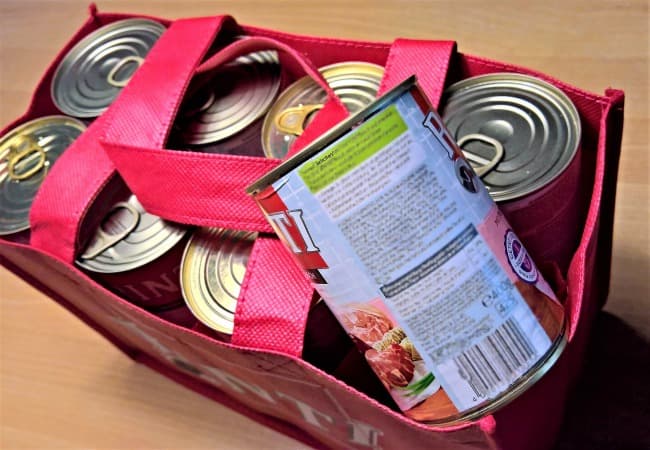FYI: If you buy something through a link on this site I may earn a commission - at NO extra cost to you.
Best Canned Puppy Food Choices
Is canned puppy food a good choice for your puppy?
A simple question, with a not-so-simple answer.
There are several different things to consider before choosing a food for little Fido including his size/age/breed and the ingredients, quality and form that food takes.
Canned (aka wet) food can be a good choice for some pets.... especially young puppies, tiny breeds, older dogs, and those with certain health conditions.

But if you want to feed your puppy a canned diet, there are a few things you need to know in order to pick a premium wet food with the right balance of nutrition.
As with the dry kibble, the most important thing you need to consider are the quality and type of ingredients that are providing his nutrition.
Choosing Canned Puppy Food
The AAFCO (The Association of American Feed Control Officials) lay down guidelines for dog food manufacturers to follow, and one of them is that every dog or puppy food must meet some minimum levels of all the basic nutrient components (ie protein, fiber, fat & moisture).
On my Best Puppy Food Choices page (this link will open in a new window) you can see which ingredients are the ones you want to see, and the ones that you don't. It also has information on the recommendations for percentage value of each component.
Here are a few formulas that have what you're looking for......
Whether it's canned or dry puppy food, the best ones contain :
- Whole meat protein source*, human grade/USDA Grade 1
- Whole grains (unless food is grain-free of course)
- Fat from a clearly labeled source eg. 'chicken fat'
* Protein should be from an identifiable animal such as beef, lamb or chicken and you don't want to see the words 'by products'
The percentage ratios/figures on the page I mentioned above are for DRY PUPPY FOOD, but you'll need to make an adjustment for canned
puppy food.
This is because it usually contains between 75% and 80% water (while dry food only contains about 10% water). So, in order to compare 'apples to apples', you want to be comparing the ingredients without the moisture.
Here's a simple way to do this:
- Find the % given for moisture and subtract it from 100. This gives you the basic 'dry weight' to start from.
- Find the % figure given on the can/bag for each component individually, and divide it by the 'dry-weight' percentage, then multiply by 100. This gives you the true % figure.
If you're like me and math isn't your strong suit this might sound confusing, but it's actually pretty simple.
Here's an example:
You know the canned puppy food you're considering contains 78% moisture and 10% protein because it says so on the label. So start out by subtracting 78% from 100% which gives you 22%
Take the 10 (%) protein figure and divide it by 22, which gives you .45, and multiply that by 100, which equals 45.45... which is 45.45% - that's the percentage of protein in this food.
100 - 78 = 22
10 ÷ 22 = .45
.45 x 100 = 45.45
...... so the percentage of protein is actually just over 45%
You can do this for each ingredient and then you can compare that to dry puppy food to see the differences between them.
Overall puppy or dog food that is canned generally contains a higher percentage of protein than the dry variety, and a lower percentage of carbohydrates.
This makes it a not-so-great choice for large or giant breed puppies who need a below-average and strictly controlled amount of protein (a recommended maximum of around 25%) to prevent potential bone/joint problems caused by too-rapid growth.
Pros & Cons of Wet Puppy Food
Using canned puppy food does have it's advantages. Here are a few of them:
- Tastes and smells appetizing, so your pup is more likely to 'dig in'
- Long shelf-life BEFORE opening
- It's softness makes it easy for young puppies, or tiny dogs, to eat
- Often contains less artificial preservatives as the canning process preserves the food itself
And here are some of the disadvantages:
- High moisture content means less nutrition per mouthful
- Short shelf-life AFTER opening, needs to be refrigerated and spoils quickly
- High protein levels make it poor choice for large breeds & can cause tummy upsets in some pups
- Results in more frequent, and looser, stools
- The higher price per ounce (or pound!) can make it too expensive for large-breed pups
Sometimes you can strike a 'happy medium' by feeding both dry puppy kibble and wet puppy food, mixed together.
If you have a 'picky eater' or a small breed puppy who needs a bit more protein, this may be a good solution. But try to stick to a ratio of 25% canned food to 75% dry, or at the most a 30:70 split.
Of course, using canned food is just one option for feeding your little one. Dry kibble is the most popular option for puppies and dogs alike.
It's very important to get the balance of nutrients right when feeding puppies so a high quality commercial food is often the easiest route to take. However, for older pups and adult dogs you can try making dog food at home, or feeding a raw diet.
you might also like...
- Home
- Puppy Food 101
- Canned Puppy Food
FTC Disclosure: Some pages on this site contain affiliate links. I may earn on qualified purchases.









